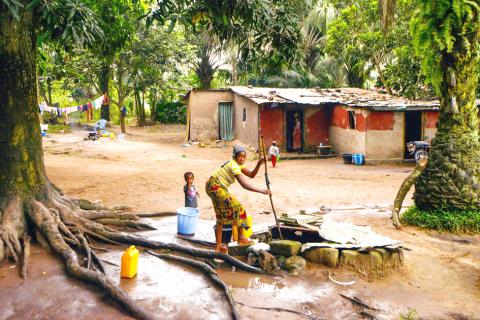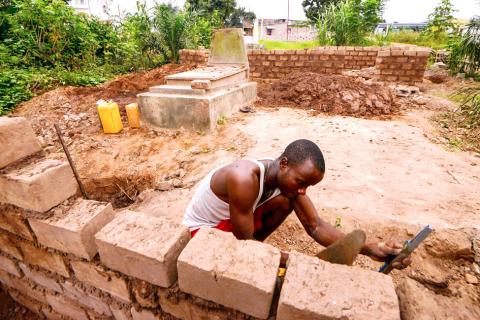In a cemetery in the Democratic Republic of the Congo (DR Congo) overrun with weeds, where trash is strewn among the graves and banana trees, the living have moved in with the dead.
For want of money and space, families have built houses out of earth, brick or sheet metal alongside tombs — some of prominent figures like the father of Congolese first lady Marie Olive Lembe di Sita Kabila — in the Kinsuka Cemetery in Kinsuka, southwest of Kinshasa, the country’s capital.
As they attempt to lead normal lives in this unlikely setting, the cemetery dwellers, who number at least in the several hundreds, are not only living on the land illegally, but still face dangerous sanitary conditions.

Photo: AFP
“You’re afraid you’re going to dig up a bone,” 19-year-old Emile said as he worked on the foundation for his elder brother’s new house just steps away from a well-tended grave.
Should he, or the others, degrade a tombstone they face up to six months in prison, while living without a proper land title could mean a year in jail under the country’s penal code.
Neighbour Bibiche, 23, has lived in the cemetery for two years, but says it is still an unsettling experience.

Photo: AFP
“You feel afraid sleeping amidst the graves, but we had no home,” she said. “The cemetery isn’t good, we have no electricity.”
Yet other cemetery residents say they do have electricity and pay a “bill” to national power company SNEL.
Despite its vast mineral wealth, two-thirds of the DR Congo’s 68 million people are mired in poverty, exacerbated by back-to-back wars that ravaged the country from 1996 to 2003 and left a complex web of rebel groups still terrorizing the eastern provinces.
Finding housing is a constant struggle for many, and large numbers of civilians — and even police and soldiers — have taken to the country’s cemeteries to find a place to call home.
Yet life among the gravestones is no free ride, said Therese, a five-year resident of Kinsuka. The 57-year-old widow paid a local chieftain to buy four plots of land with her children’s help.
“They cost between US$2,500 to US$4,000 each,” said Therese, who like all the cemetery residents only gave her first name for fear of reprisal.
Inside her two-room house, the bedroom has a mosquito net, but no bed to be draped over.
“In November, the police came to destroy the houses. They took my things,” Therese said. “I had to rebuild my house, but I don’t have the courage to rebuild on my other plots that I wanted to rent out.”
Despite the difficulties, scenes typical of village life have still managed to sprout up in the cemetery. The dirt paths are lined with wooden stalls selling food and basic supplies, and children in traditional blue-and-white kits play soccer at a Protestant school built inside the graveyard three years ago.
“Today, it has about 150 students. Parents pay 78,000 Congolese francs [about US$80] per year, against US$300 to US$400 elsewhere,” the school’s director said.
In some parts of cemetery, the construction of homes has made it harder to locate remaining burial plots. The graveyard was founded in 1978 and is the final resting place of several well-known figures, such as engineer Sita Barnabe Kinsumbu, Kabila’s father, a local burial tax collector said.
Government officials say the homes in Kinsuka and other cemeteries across the country constitute a public health hazard, citing the up to 50 years it take after a site’s last burial to ensure that he ground is fully decontaminated.
“Sometimes people find a source of water, but when you sniff it, it smells like a corpse,” said Benjamin Mavard Kwengani, a physician who is director of hygiene at Congolese Ministry of Health.
“We haven’t done a study, but there have been abnormal cases in the [cemetery] communities — diarrhea and abnormalities that we can’t explain,” he said.
According to Pius Ngoie, an adviser to the urban planning ministry, cemetery villages only continue to exist due to negligence and corruption within the civil service.
“Some of the state’s civil servants ... are completely irresponsible” and “fraudulently” sell tracts of land in the cemetery, he said.
The cemetery dwellers are under no illusions that their homes could be razed at any moment.
“One day, a [state] tractor is going to come and knock down the houses and they will lose everything,” said Peter, whose father and grandfather are buried at Kinsuka.
His words turned out to be prophetic. Just a few days later, soldiers arrived to destroy some of the homes built on the remains of this final resting place.

SEEKING CLARITY: Washington should not adopt measures that create uncertainties for ‘existing semiconductor investments,’ TSMC said referring to its US$165 billion in the US Taiwan Semiconductor Manufacturing Co (TSMC, 台積電) told the US that any future tariffs on Taiwanese semiconductors could reduce demand for chips and derail its pledge to increase its investment in Arizona. “New import restrictions could jeopardize current US leadership in the competitive technology industry and create uncertainties for many committed semiconductor capital projects in the US, including TSMC Arizona’s significant investment plan in Phoenix,” the chipmaker wrote in a letter to the US Department of Commerce. TSMC issued the warning in response to a solicitation for comments by the department on a possible tariff on semiconductor imports by US President Donald Trump’s

The government has launched a three-pronged strategy to attract local and international talent, aiming to position Taiwan as a new global hub following Nvidia Corp’s announcement that it has chosen Taipei as the site of its Taiwan headquarters. Nvidia cofounder and CEO Jensen Huang (黃仁勳) on Monday last week announced during his keynote speech at the Computex trade show in Taipei that the Nvidia Constellation, the company’s planned Taiwan headquarters, would be located in the Beitou-Shilin Technology Park (北投士林科技園區) in Taipei. Huang’s decision to establish a base in Taiwan is “primarily due to Taiwan’s talent pool and its strength in the semiconductor

Industrial production expanded 22.31 percent annually last month to 107.51, as increases in demand for high-performance computing (HPC) and artificial intelligence (AI) applications drove demand for locally-made chips and components. The manufacturing production index climbed 23.68 percent year-on-year to 108.37, marking the 14th consecutive month of increase, the Ministry of Economic Affairs said. In the first four months of this year, industrial and manufacturing production indices expanded 14.31 percent and 15.22 percent year-on-year, ministry data showed. The growth momentum is to extend into this month, with the manufacturing production index expected to rise between 11 percent and 15.1 percent annually, Department of Statistics

An earnings report from semiconductor giant and artificial intelligence (AI) bellwether Nvidia Corp takes center stage for Wall Street this week, as stocks hit a speed bump of worries over US federal deficits driving up Treasury yields. US equities pulled back last week after a torrid rally, as investors turned their attention to tax and spending legislation poised to swell the US government’s US$36 trillion in debt. Long-dated US Treasury yields rose amid the fiscal worries, with the 30-year yield topping 5 percent and hitting its highest level since late 2023. Stocks were dealt another blow on Friday when US President Donald